From Complaints to Happier Customers
and Better Products
June—September 2019 | 12 weeks | Research & Strategy Project
CLIENT A Midwestern regional retail bank
TEAM Lead Researcher | Researcher (myself) | Visual Designer
MY ROLE Research planning | Workshops facilitation | Interviews facilitation | Synthesis and insights communication | Coordinating recruiting with vendors
Overview
When customers complain, what can a business do to turn the crisis into an opportunity to inspire customer loyalty and improve the products and services? In this 12-week research and strategy effort, we helped a regional retail bank understand how their customers and associates deal with complaints and how to transform their customer complaint management process and system.
CONTENTS The Ask | Process | Research & Insights | Strategy | Reflections
THE ASK
Develop strategies to improve the complaint management process
Our client, a regional retail bank in the Midwest, was looking to update the technology for its customer complaint management system. They wanted to use this technology overhaul as an opportunity to improve the process for both bank employees and customers.
Today’s process is messy and inefficient. When a customer expresses any dissatisfaction, it can take at least 3 months for that complaint to reach a business unit who might have the power to address it. Sometimes, a complaint never reaches the right department.
The client asked us to investigate how to improve the complaint management process and develop strategies to achieve the ideal state.
PROCESS
We are on this journey together
Many departments in the bank are involved in the complaint management process, and each plays an important role:
- Office of Customer Advocacy (our core stakeholders who initiated the project)
- Maintains a customer complaints database
- Frontline departments (e.g., branches, call centers)
- Resolve issues for customers
- Document complaints
- Business units (e.g., mortgage, credit card)
- Analyze complaints data to improve products and services
- Assist frontline to resolve customer issues
We were aware that keeping all stakeholders aligned would be a challenge. That’s why we paid close attention to collaboration at each step — working closely with the core stakeholders, and engaging the extended stakeholders at the right time. We wanted to take our clients on the journey with us so that there would be no big reveal and surprises at the end of it.
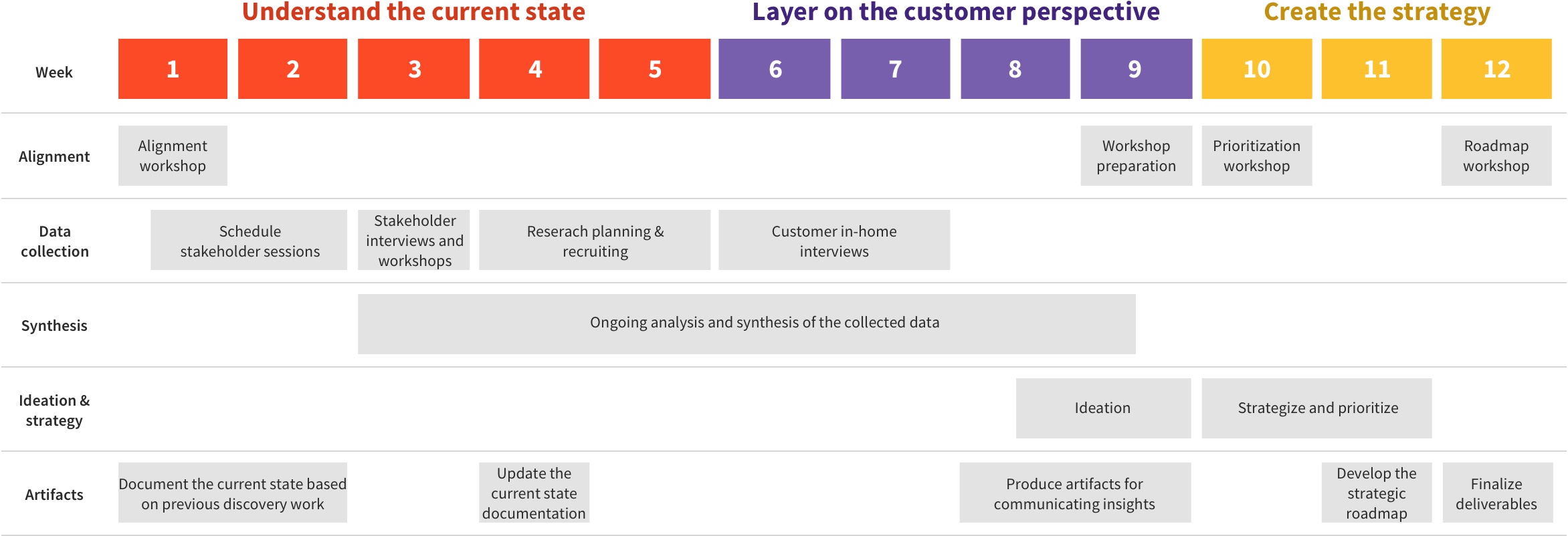
Project timeline
RESEARCH & INSIGHTS
There are two sides to the same story
What we did
Stakeholder interviews and workshops
To understand the current state of complaint management, we talked to 35 bank associates from 11 departments in individual and group settings. We collected stories and challenges of providing customer services at the frontline and back offices.
Customers in-home interviews
Next, we interviewed 24 customers about their recent experience filing a complaint with their banks. We curated some text- and image-based stimuli to help participants recall details of their experience and share their stories and inspirations.
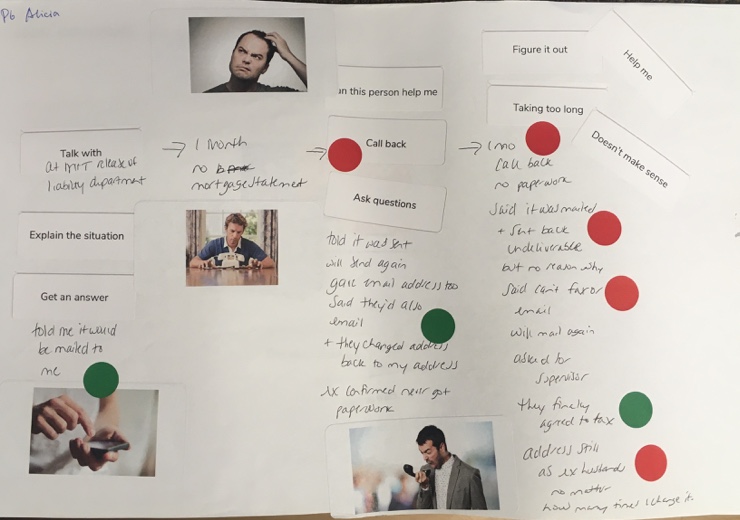
Current experience timeline
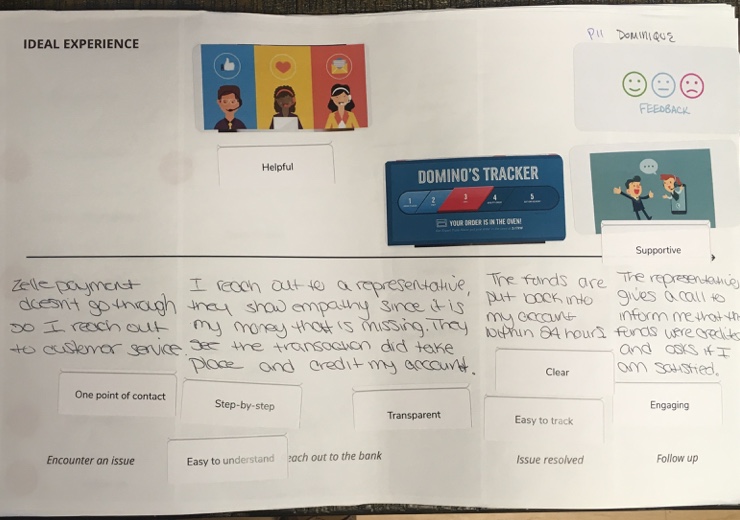
Ideal experience timeline
Synthesis
For a good part of this project, the ongoing synthesis happened in various forms —
- End-of-day debriefs during fielding
- Coding data and creating themes
- Brain-writing and affinity diagrams (both digitally and on actual walls)
- Creating blueprints, experience maps, flow charts, and other diagrams
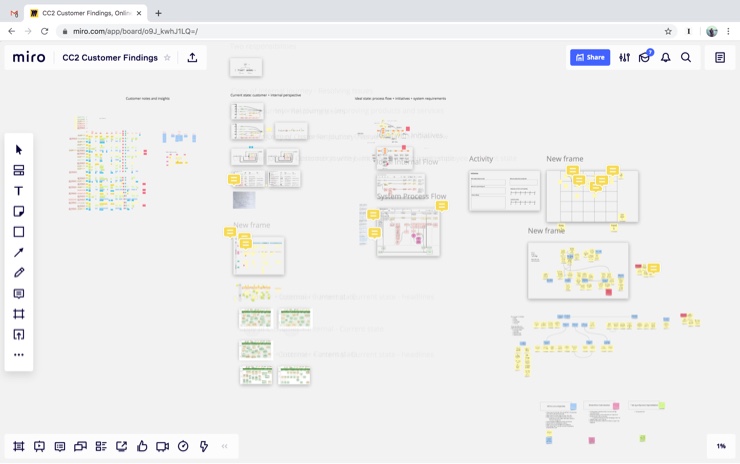
Miro board where we visually lay out data, synthesize, and create artifacts
What we learned
Neither customers and associates were content with the current complaint management process. As illustrated in the map below, customers and associates were experiencing various pain points caused by the very same underlying issues with the policies, organization structure, and technology of the bank. For example, not every channel has the same power to override policies for customers, which causes customers to have to go through multiple channels and leaves associates frustrated about being unable to help customers.
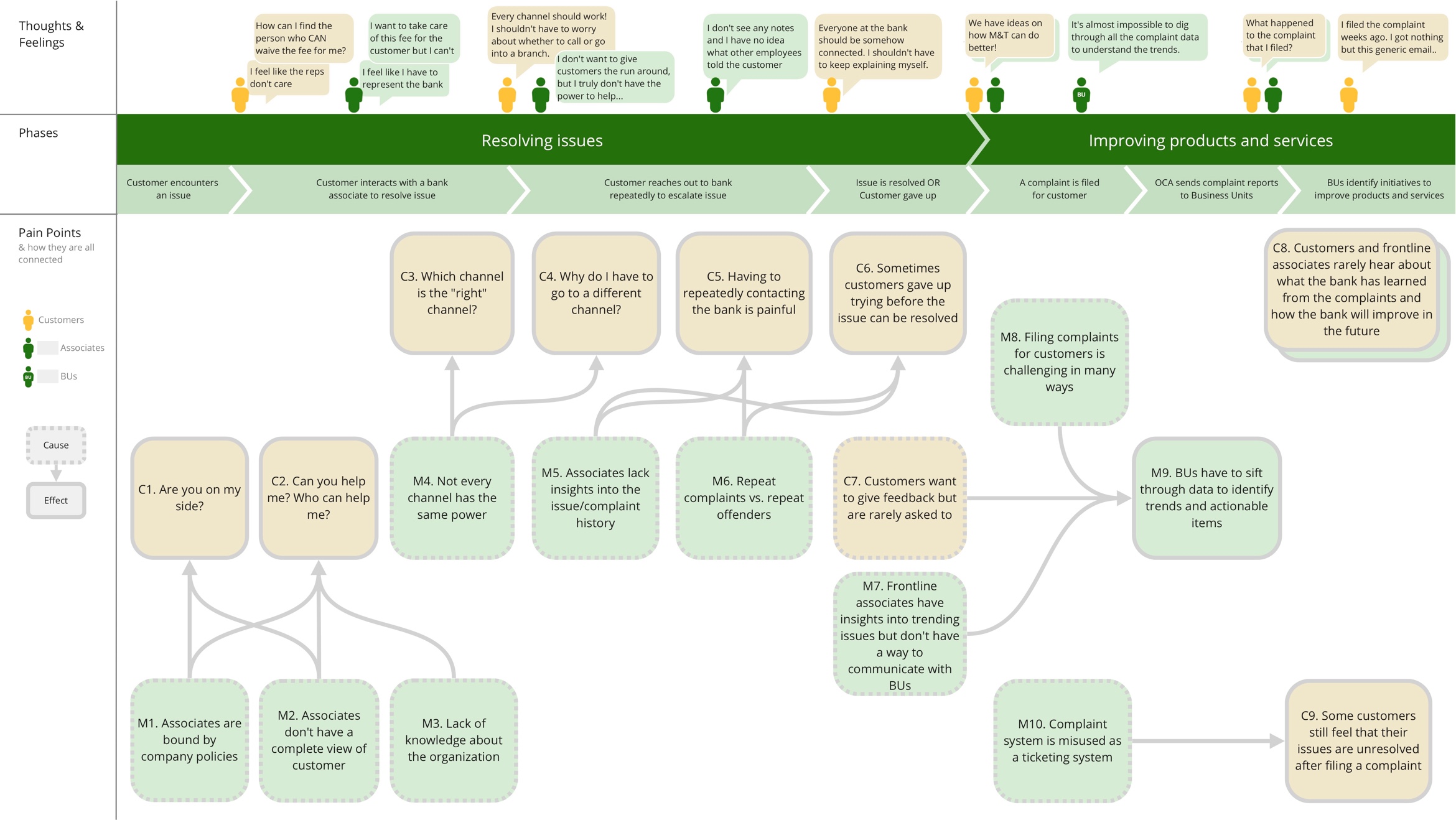
Experience map with a focus on pain points comparison
STRATEGY
Find the North Star in this organizational mess
What we did
Ideation
After laying out the ideal customer and associate journey, we identified 20 potential initiatives to strive toward the ideal state. The proposed initiatives aimed to improve the complaint management process by updating the technology and, more importantly, transforming how the organizations work together.
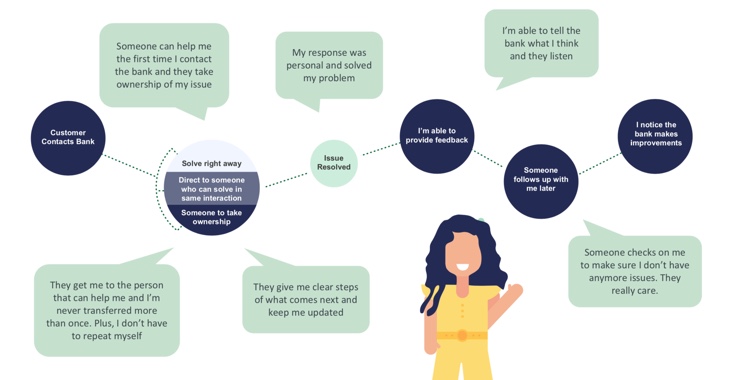
Ideal customer journey illustration
Prioritization workshop
To utilize the whole organization’s knowledge to prioritize the proposed initiatives, we facilitated a full-day workshop with more than 20 stakeholders from departments involved in the complaint management process. Activities include:
- Immersing everyone in the research stories, learnings, and insights
- Breaking stakeholders into diverse teams
- Each team following a worksheet to identify the implications, feasibility, constraints, risks, and key players for each initiative assigned to them
- The group coming back together to present, discuss, and plot the initiatives on a value-by-feasibility matrix
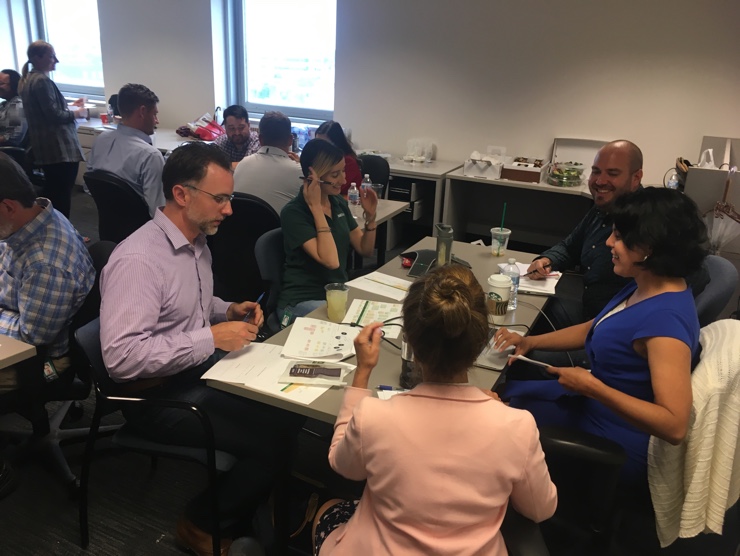
We included stakeholders from different departments on the same teams to ensure diverse perspectives
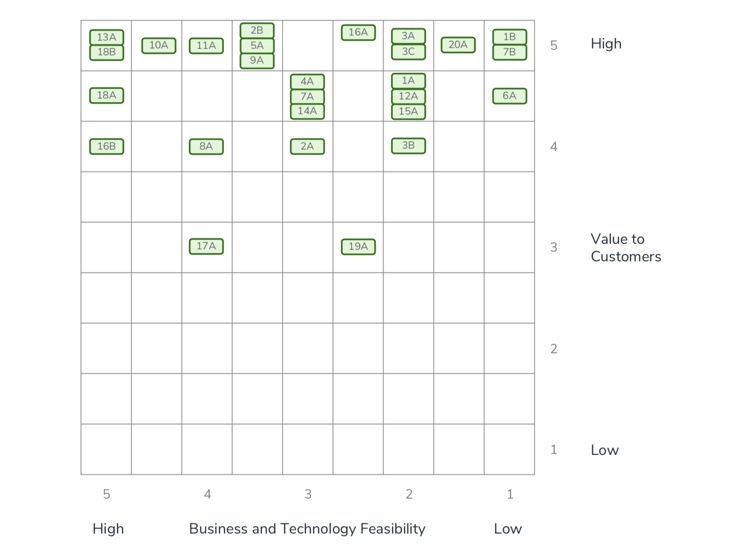
Initiatives were arranged on a matrix according to relative value and feasibility
Strategic roadmap
We now faced the challenge of prioritizing 20 interdependent initiatives. To orient ourselves in the overwhelming amount of information, we identified six desired experiential outcomes (A-F below) and aligned each initiative to one of the outcomes. We then sorted the initiatives into four stages (1-4 below) by considering the dependencies between initiatives and the time constraint imposed by the retirement of the old system.
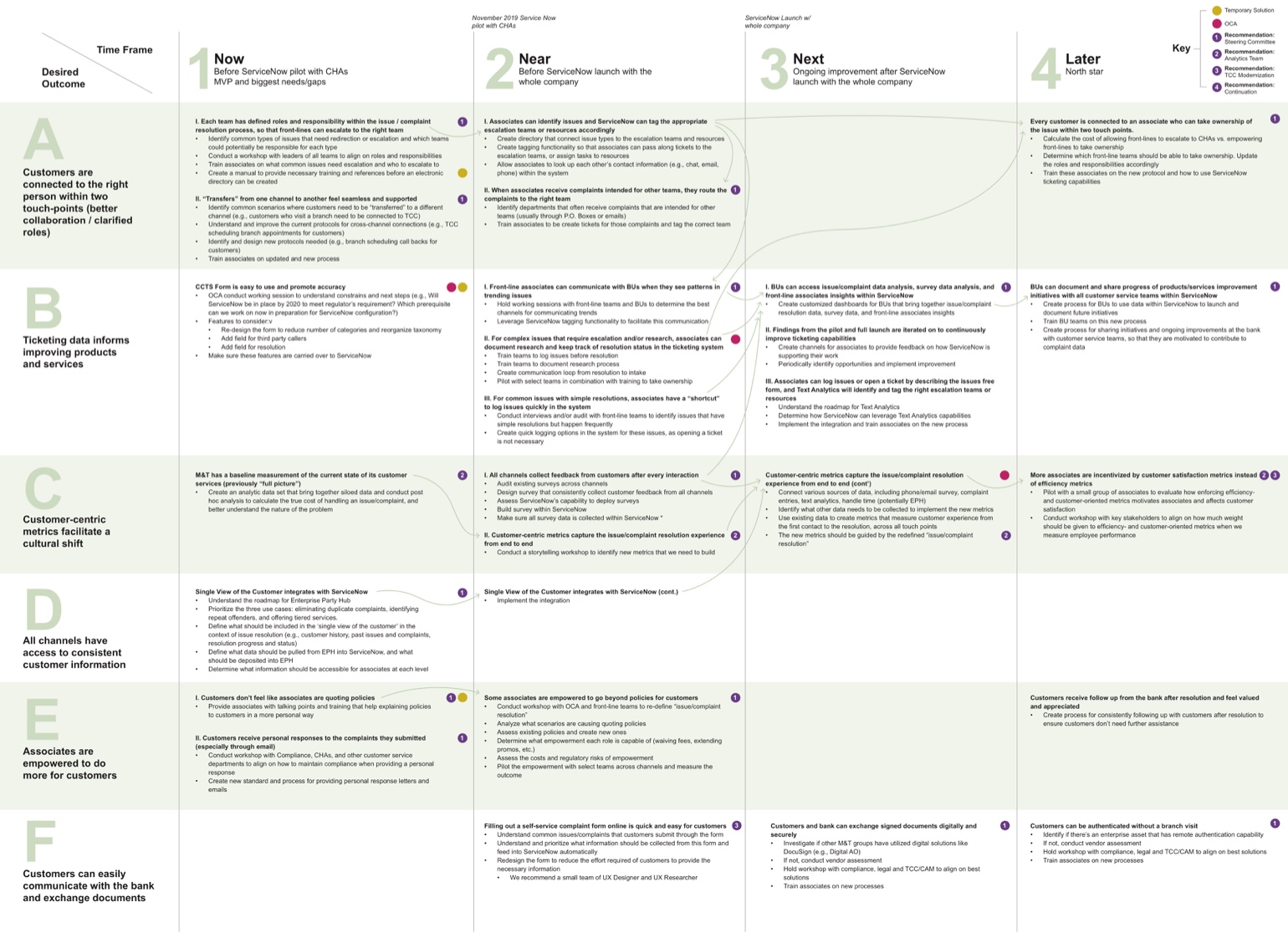
Strategic roadmap: Arrows indicate dependencies between initiatives.
Next steps
When the time came to hand the project back to the client, we wanted to make sure they felt comfortable with the strategy and had everything they need to plan the next steps. In a half-day workshop with core stakeholders, we shared the strategic roadmap and facilitated a group discussion to make plans for the near-term initiatives, including (i) identifying owners and key players, (ii) setting next steps and key dates, and (iii) calling out risks and blockers.
Reflections
Stories are a natural and powerful way to connect people. In the context of design, researchers facilitate that connection between users, designers, and stakeholders
Collecting stories — Creative toolkits, even the very simple ones, can help research participants open up and tell their stories. Ask participants to think back to a specific past experience and draw you a timeline. Reassure them that they can do it however they want. Offer a set of stimuli to jog the memory — nouns and verbs that might represent a component of the story, images that might evoke emotions.
Crafting the narrative — Coming back from the field, we took apart what we heard, immersed ourselves in the data, and then tried to roll all the insights into a larger story. The fact that all the insights are somehow connected and intertwined made finding a comprehensive yet succinct narrative a huge challenge. I had to remind myself that my goal wasn’t to find THE perfect story, but rather ONE that is simple enough and still connects all the ideas. (How did I know it’s good enough? I tested it with coworkers that weren’t on the project.)
Telling stories — Researchers love to bring up anecdotes to support the findings. Not because anecdotes prove anything, but because the audience can empathize with a real person but not a statistic. Some of them will gasp, smile, and say “Oh, yes, I get it. That reminds me of …” I used to be very self-conscious when I brought up the same story again and again. I worried that my audience would notice the repetition and get bored. But there’s magic in repetition — it’s how stories stick with people and become contagious.
What to do when a deliverable is specified in the statement of work, but the research reveals it would not provide the needed value?
According to the statement of work, we were supposed to create a detailed service blueprint to capture the current state of the complaint management processes. We soon realized that due to the variety of customer service scenarios, we would actually be creating one blueprint each for more than a dozen scenarios. It would be tedious and time-consuming, but not very practical or useful.
While it was important to read the contract and make sure we check off all the boxes, we couldn’t lose sight of the value we were trying to deliver through the deliverables. The purpose of documenting the current state was to help all stakeholders see the whole picture and identify the gaps and opportunities. In this case, one or two flowcharts that illustrate the workflows and pain points would be more efficient and digestible than a dozen of blueprints.
In the end, we explained to our client why we made flowcharts instead of blueprints, and the client was on board with it. We also created blueprints for a couple common scenarios to satisfy the contract. In hindsight, we could have just taken the time to amend the statement of work.
When you and your teammates think and/or communicate differently, over-communicate, try new methods, and find what works for both of you
When I try to make sense of things, any form of structure (e.g., a table, a tree, a diagram, a story) brings me comfort in the chaotic sense-making process. On the other hand, my teammate’s way of thinking is much more fluid than mine. Conversations with her often leap from one topic to another, so quickly that they sometimes overwhelmed me in the beginning of this project.
I’m glad we took the time and effort to figure out what our common language is and eventually learned to appreciate the unique things that the other brings to the table. Lessons learned:
- It can be frustrating, but keep in mind that there’s no one right way to communicate between two people and there’s no one to blame.
- Over-communicate when you have the slightest doubt about whether you’re on the same page. E.g., “Can I say back to you what I think I heard?”
- Try different techniques — talking it out, brain-writing, white-boarding, using lots of post-its, sticking to a detailed agenda. Keep trying and find out what works for both of you.
More work
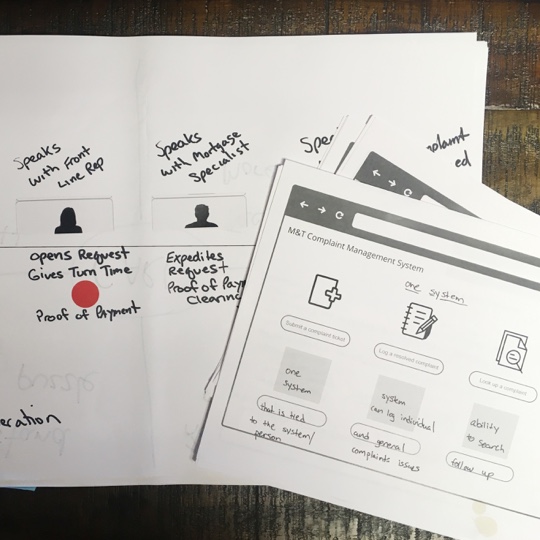
From complaints to happier customers and better productsdiscovery | experience strategy | 2019
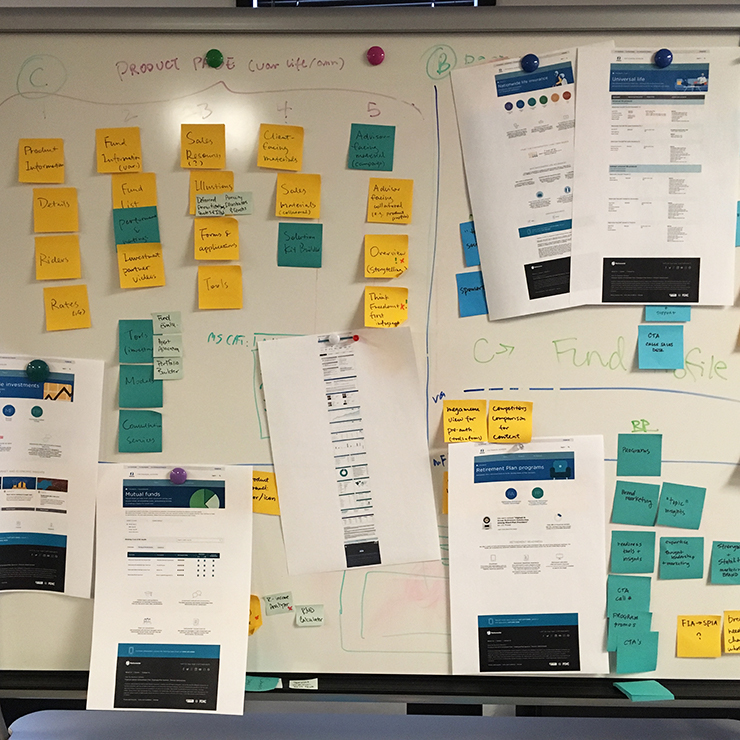
Navigate Complexity: Nationwide Financial Website Redesigngenerative | evaluative | concurrent projects | 2018
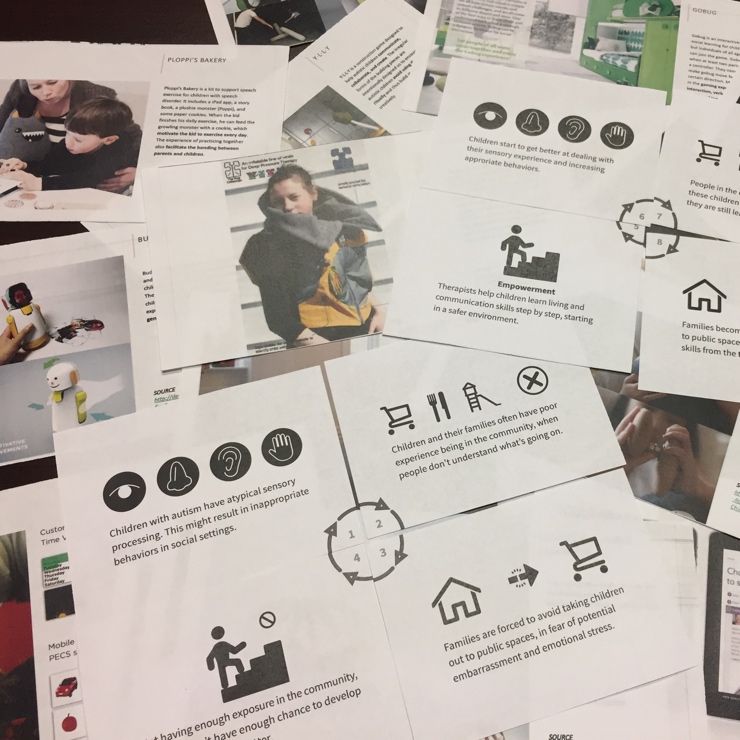
Design for Autism: Empowerment, Awareness, and Acceptancegenerative | co-design | research through design | 2017

Health Insurance Simplifiedgenerative | experience design | 2016
© 2019 Yiying Yang